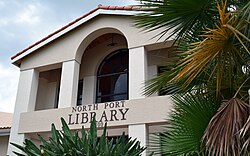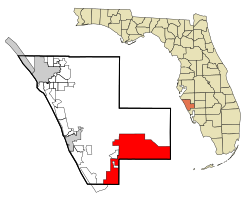
Back نورث بورت (فلوريدا) Arabic نورث بورت ARZ نورت پورت، فلوریدا AZB North Port Catalan Норт-Порт CE North Port (lungsod) CEB North Port, Florida Welsh North Port (Florida) German North Port Spanish North Port (Florida) Basque
North Port, Florida | |
|---|---|
 The North Port Public Library | |
| Etymology: Shortened form of North Port Charlotte | |
| Motto: "Achieve Anything" | |
 Location in Sarasota County and the state of Florida | |
| Coordinates: 27°3′58″N 82°10′19″W / 27.06611°N 82.17194°W[1] | |
| Country | |
| State | |
| County | Sarasota |
| Incorporated (City of North Port Charlotte) | June 18, 1959[2][3] |
| Reincorporated (City of North Port) | 1974[2][3] |
| Government | |
| • Type | Commission-Manager |
| • Mayor | Phil Stokes |
| • Vice Mayor | Pete Emrich |
| • Commissioners | Barbara Langdon, Demetrius Petrow, and David Duval |
| • City Manager | Alfred Jerome Fletcher, II |
| • City Clerk | Heather Faust |
| Area | |
• City | 104.21 sq mi (269.91 km2) |
| • Land | 99.38 sq mi (257.39 km2) |
| • Water | 4.83 sq mi (12.52 km2) 4.40% |
| Elevation | 10 ft (3 m) |
| Population (2020) | |
• City | 74,793 |
• Estimate (2022) | 85,099 |
| • Density | 752.60/sq mi (290.58/km2) |
| • Urban (Port Charlotte–North Port, FL) | 199,998 (US: 194th)[5] |
| • Urban density | 1,484.8/sq mi (573.3/km2) |
| • Metro | 859,760 (US: 70th) |
| • CSA | 1,089,011 (US: 56th) |
| Time zone | UTC−05:00 (EST) |
| • Summer (DST) | UTC−04:00 (EDT) |
| ZIP codes | 34286-34291, 34293 |
| Area codes | 941 |
| FIPS code | 12-49675 |
| GNIS feature ID | 0294334 |
| Website | cityofnorthport |
| [6] | |
North Port is a city located in Sarasota County, Florida, United States. The population was 74,793 at the 2020 US Census,[7] up from 57,357 at the 2010 US Census.[8] It is a principal city in the North Port–Bradenton–Sarasota, Florida Metropolitan Statistical Area.
It was originally developed by General Development Corporation (GDC) as the northern Sarasota County portion of its Port Charlotte development, the other portion located in the adjacent Charlotte County. GDC dubbed the city, "North Port Charlotte", and it was incorporated under that name through a special act of the Florida Legislature on June 18, 1959. By referendum in 1974, the city's residents approved a change to its name as "North Port", dropping "Charlotte" from its name to proclaim the city as a separate identity.[2][3] It is home to the Little Salt Spring, an archaeological and paleontological site owned by the University of Miami.
- ^ "US Gazetteer files: 2010, 2000, and 1990". United States Census Bureau. February 12, 2011. Retrieved April 23, 2011.
- ^ a b c City of North Port History Book
- ^ a b c City of North Port Charter, §1.02, City Ordinance 74-5
- ^ "2020 U.S. Gazetteer Files". United States Census Bureau. Retrieved October 31, 2021.
- ^ "List of 2020 Census Urban Areas". census.gov. United States Census Bureau. Retrieved January 8, 2023.
- ^ "North Port". Geographic Names Information System. United States Geological Survey, United States Department of the Interior. October 19, 1979. Retrieved January 14, 2019.
- ^ US Census Bureau. "US Census Bureau Quick Facts - North Port city, Florida". US Census Bureau Quick Facts. Retrieved September 24, 2021.
- ^ "North Port city, Florida". Profile of General Population and Housing Characteristics: 2010; 2010 Demographic Profile Data. U.S. Census Bureau. Archived from the original on February 12, 2020.

